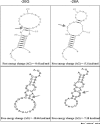Implication of BRCA2 -26G>A 5' untranslated region polymorphism in susceptibility to sporadic breast cancer and its modulation by p53 codon 72 Arg>Pro polymorphism
- PMID: 17945002
- PMCID: PMC2242669
- DOI: 10.1186/bcr1780
Implication of BRCA2 -26G>A 5' untranslated region polymorphism in susceptibility to sporadic breast cancer and its modulation by p53 codon 72 Arg>Pro polymorphism
Abstract
Introduction: The absence of mutation or promoter hypermethylation in the BRCA2 gene in the majority of breast cancer cases has indicated alternative ways of its involvement, deregulated expression being one possibility. We show how a polymorphism in the 5' untranslated region (UTR) of BRCA2 can serve as one such factor. Based on the hypothesis that variants of genes involved in the same pathway can influence the risk provided for breast cancer, the status of p53 codon 72 polymorphism was also investigated and a possible interaction between the polymorphisms was examined.
Methods: The luciferase reporter assay followed by RNA secondary structure analysis was used for the functional characterization of -26 5' UTR G>A polymorphism in BRCA2. The genotype and the allele frequency for the polymorphisms were determined and relative risk adjusted for age was calculated in a case-control study of 576 individuals (243 patients and 333 controls) from north India.
Results: -26 G>A polymorphism in the 5' UTR of BRCA2 was found to be functional whereby the A allele increased the reporter gene expression by twice that of the G allele in MCF-7 (P = 0.003) and HeLa (P = 0.013) cells. RNA secondary structure analysis by two different programs predicted the A allele to alter the stability of a loop in the vicinity of the translation start site. Its direct implication in breast cancer became evident by a case-control study in which the heterozygous genotype was found to be protective in nature (P heterozygote advantage model = 0.0005, odds ratio [OR] = 0.5, 95% confidence interval [CI] = 0.4 to 0.8), which was further supported by trends observed in a genomic instability study. The p53 codon 72 Arg homozygous genotype was found to be over-represented in patients (P = 0.0005, OR = 2.3, 95% CI = 1.4 to 3.6). The interaction study indicated an increased protection under simultaneous presence of protector genotypes of both the polymorphic loci (P = 0.0001, OR = 0.2, 95% CI = 0.1 to 0.4).
Conclusion: Our study shows that -26 5' UTR polymorphism in BRCA2 can modulate the fine-tuned regulation of the multifunctional gene BRCA2 and renders risk or protection according to the genotype status in the sporadic form of breast cancer, which is further influenced by the germline genetic backgrounds of codon 72 polymorphism of p53.
Figures



References
-
- Vaughn JP, Cirisano FD, Huper G, Berchuck A, Futreal PA, Marks JR, Iglehart JD. Cell cycle control of BRCA2. Cancer Res. 1996;56:4590–4594. - PubMed
Publication types
MeSH terms
Substances
LinkOut - more resources
Full Text Sources
Medical
Research Materials
Miscellaneous

